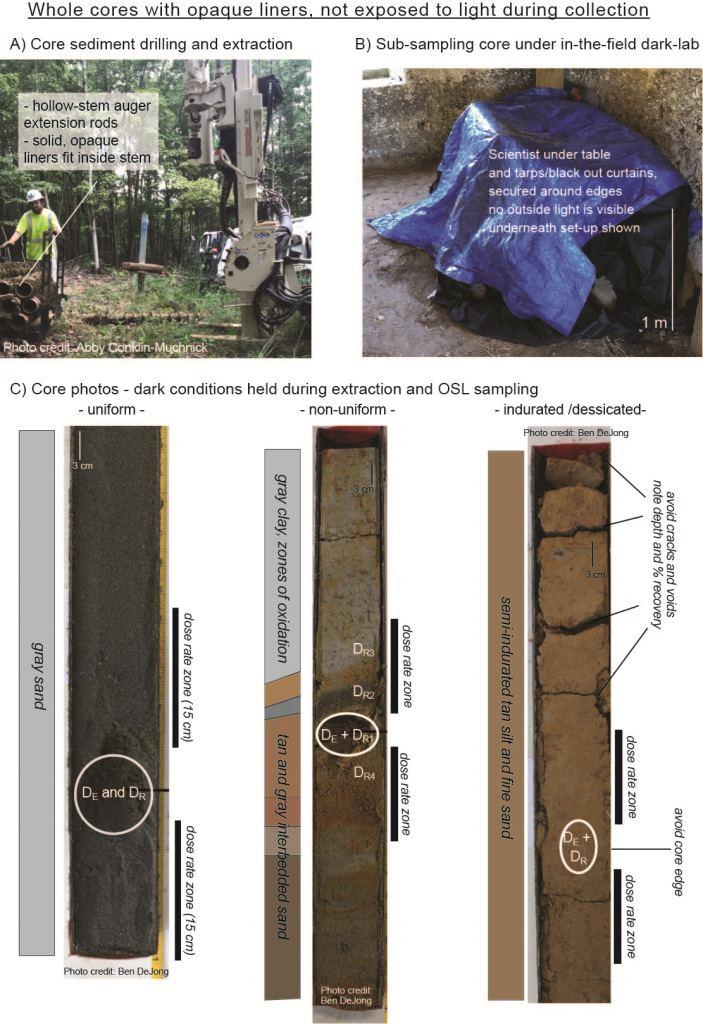Core samples
There are several ways subsurface core samples may be submitted to the USU Luminescence Lab for dating. Both DE and DR samples will be collected from the cores.
Here is a brief overview of the core scenarios.


- Two Whole Cores
- Preferably two cores taken side by side will allow for core description and the second will be light-safe for luminescence samples.
- Small sections of the light-tight core (40 cm) should be cut and mailed to the lab for sample extraction [in the dark room].
- Only the innermost, non-light exposed sediment will be collected for the DE sample.
- DR will come from the outer material around the DE and above and below the DE sample.
- One whole core, light-proof liner
- Preferably two cores taken side by side will allow for core description and the second will be light-safe for luminescence samples.
- Small sections of the light-tight core (40 cm) should be cut and mailed to the lab for sample extraction [in the dark room].
- Only the innermost, non-light exposed sediment will be collected for the DE sample.
- DR will come from the outer material around the DE and above and below the DE sample.
- One whole core, light-proof liner
- DE targets may need to be determined in the dark when detailed stratigraphy is observable.
- Send longer core sections if there is less certainty on stratigraphy (ideally >40, <60 cm).
- Only the innermost, non-light exposed sediment will be collected for the DE sample.
- DR will come from the outer material around the DE and above and below the DE sample.
- Split cores -half core exposed to light
For core samples that have been split and exposed to light, they can still be sampled for luminescence dating but require extra caution during sampling.
Set up a temporary dark room: papsdfas- The core may be sampled under dark conditions with only the aid of a red-light lamp (like those used on bike lights).
- The upper 1 cm of sediment that was exposed to light at the split face should be extracted for the DR sample.
- Only the innermost sediment, never exposed to light, may be put into a light-safe container for the DE sample.
- Sediments with 1 cm of the core liner will be discarded because they may be translocated from other horizons during drilling.
- DR will come from the outer material around the DE and stratigraphically above and below the DE sample.
Extra notes related to core samples:
- The geographic location and depth below the land surface is required.
- Provide the best estimate for absolute depth if there has been significant loss of core during drilling, note the recovery of the core sections.
- Notes on core compaction should be added as this affects the moisture content needed as part of the dose rate calculation.
- Fluctuations or lack thereof in moisture content must also be noted when submitting core samples.
- New project form (pdf)
- Sediment samples (pdf)
- Sediment samples (.xlsx)
- Samples from single cores (.xlsx)
- Samples from multiple cores (.xlsx)
Send samples to:
USU Luminescence Lab
1770 North Research Parkway, Suite 123
North Logan, UT 84341
All samples should be labeled 'Light-sensitive mineral samples for geologic analysis. All material will be consumed in analysis. No monetary value'.
International samples: Send via international shipping company such as UPS, FedEx, DHL, TNT, do not use local postal service.
Email tracking number to Tammy or Michelle.

